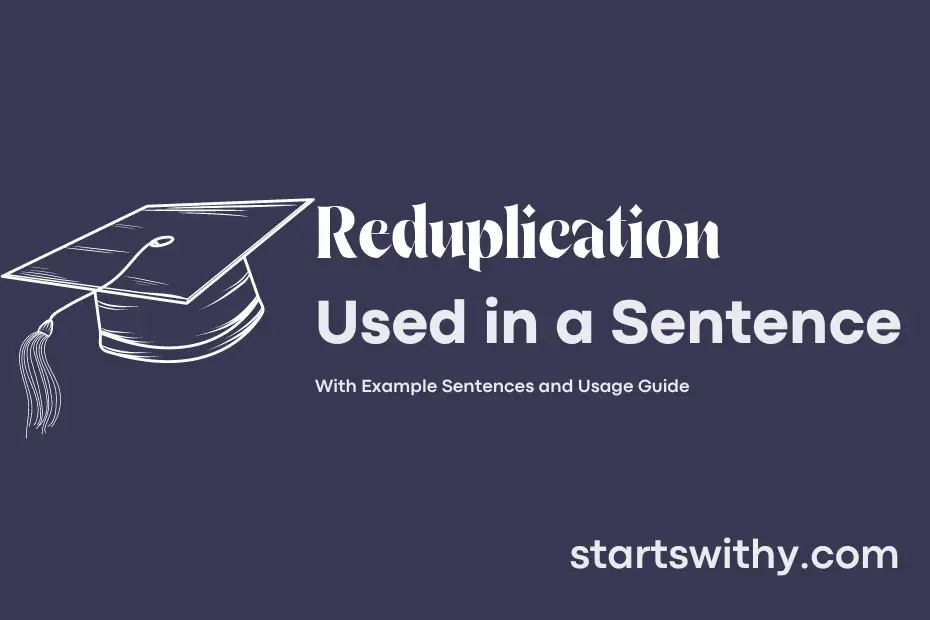Have you ever noticed how certain words in different languages seem to repeat themselves? This linguistic phenomenon, known as reduplication, involves the repetition of all or part of a word to convey a specific meaning or to emphasize a concept. Reduplication can occur in various forms, such as repeating a syllable, a morpheme, or an entire word.
Reduplication is a common feature in many languages and serves as a powerful tool for communication. It can indicate repetition, intensification, plurality, or even a change in meaning. From creating rhymes in nursery rhymes to expressing love through endearment terms, reduplication adds a unique flair to language that is both fascinating and diverse.
7 Examples Of Reduplication Used In a Sentence For Kids
- The chit-chat of the birds woke me up in the morning.
- Let’s play a game of hide-and-seek during recess.
- The pitter-patter of the rain was so relaxing.
- Wear your slip-slop to protect your feet in the garden.
- The little puppy made some yip-yap noises.
- The zig-zag path led us to the beautiful garden.
- We saw a flip-flop left behind on the beach.
14 Sentences with Reduplication Examples
- Reduplication is a common phenomenon in many Indian languages.
- It’s important to understand the concept of reduplication in morphology.
- The professor explained the process of reduplication in detail in the lecture.
- Students were asked to identify examples of reduplication in the language exercises.
- Reduplication is often used to express intensity or emphasis in words.
- The assignment required us to create new words through reduplication.
- Many Indian proverbs and idioms use reduplication for effect.
- Reduplication can also be seen in poetry and song lyrics.
- Understanding reduplication can help in grasping the nuances of a language.
- Some students find reduplication challenging to master initially.
- Reduplication can also be a fun way to play with words in creative writing.
- The study group discussed the different types of reduplication found in Indian languages.
- The textbook provided examples of reduplication in various regional dialects.
- Practicing reduplication exercises can improve vocabulary retention.
How To Use Reduplication in Sentences?
To use Reduplication effectively in a sentence, follow these simple steps:
-
Identify the word you want to emphasize or repeat. This is the main word that you will reduplicate.
-
Repeat the word either fully or partially, depending on the desired effect. For example, “The movie was good, good, good!” or “She smiled and smiled throughout the entire show.”
-
Reduplicate for emphasis or to convey a sense of continuous action or intensity. Reduplication can also be used for playful or poetic effect.
-
Make sure the repeated word fits the context of your sentence and enhances the overall meaning you wish to convey.
-
Experiment with different tone and inflection when reduplicating a word. The way you say the reduplicated word can alter the mood or emphasis of the sentence.
-
Practice using Reduplication in various types of sentences to become more comfortable with this literary device. Start with simple sentences and gradually incorporate reduplication into more complex writing.
Remember, reduplication can add depth, rhythm, and emphasis to your writing, making it more engaging for the reader. It’s a fun and creative way to play with language, so don’t be afraid to experiment and have fun with it!
Conclusion
Reduplication in language involves the repetition of all or part of a word to convey intensity, emphasis, or a specific meaning. Through examples like “ping-pong” or “hodgepodge,” we see how reduplication is used to create new words that often evoke a sense of playfulness, informality, or even onomatopoeia. This linguistic device can be found in various languages and serves to enhance communication by adding nuance, rhythm, or clarity to expressions.
Whether it’s for poetic effect, to emphasize a point, or simply to create catchy phrases, reduplication adds a dynamic element to language that engages the listener or reader. By recognizing and understanding these repeated patterns in words, we can appreciate the creative ways in which language evolves and shapes our communication.



